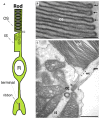Presynaptic [Ca(2+)] and GCAPs: aspects on the structure and function of photoreceptor ribbon synapses
- PMID: 24567702
- PMCID: PMC3915146
- DOI: 10.3389/fnmol.2014.00003
Presynaptic [Ca(2+)] and GCAPs: aspects on the structure and function of photoreceptor ribbon synapses
Abstract
Changes in intracellular calcium ions [Ca(2+)] play important roles in photoreceptor signaling. Consequently, intracellular [Ca(2+)] levels need to be tightly controlled. In the light-sensitive outer segments (OS) of photoreceptors, Ca(2+) regulates the activity of retinal guanylate cyclases thus playing a central role in phototransduction and light-adaptation by restoring light-induced decreases in cGMP. In the synaptic terminals, changes of intracellular Ca(2+) trigger various aspects of neurotransmission. Photoreceptors employ tonically active ribbon synapses that encode light-induced, graded changes of membrane potential into modulation of continuous synaptic vesicle exocytosis. The active zones of ribbon synapses contain large electron-dense structures, synaptic ribbons, that are associated with large numbers of synaptic vesicles. Synaptic coding at ribbon synapses differs from synaptic coding at conventional (phasic) synapses. Recent studies revealed new insights how synaptic ribbons are involved in this process. This review focuses on the regulation of [Ca(2+)] in presynaptic photoreceptor terminals and on the function of a particular Ca(2+)-regulated protein, the neuronal calcium sensor protein GCAP2 (guanylate cyclase-activating protein-2) in the photoreceptor ribbon synapse. GCAP2, an EF-hand-containing protein plays multiple roles in the OS and in the photoreceptor synapse. In the OS, GCAP2 works as a Ca(2+)-sensor within a Ca(2+)-regulated feedback loop that adjusts cGMP levels. In the photoreceptor synapse, GCAP2 binds to RIBEYE, a component of synaptic ribbons, and mediates Ca(2+)-dependent plasticity at that site. Possible mechanisms are discussed.
Keywords: Ca2+; GCAP2; RIBEYE; photoreceptor; ribbon synapse; synaptic ribbon.
Figures




Similar articles
-
Nicotinamide adenine dinucleotide-dependent binding of the neuronal Ca2+ sensor protein GCAP2 to photoreceptor synaptic ribbons.J Neurosci. 2010 May 12;30(19):6559-76. doi: 10.1523/JNEUROSCI.3701-09.2010. J Neurosci. 2010. PMID: 20463219 Free PMC article.
-
Overexpression of guanylate cyclase activating protein 2 in rod photoreceptors in vivo leads to morphological changes at the synaptic ribbon.PLoS One. 2012;7(8):e42994. doi: 10.1371/journal.pone.0042994. Epub 2012 Aug 13. PLoS One. 2012. PMID: 22912773 Free PMC article.
-
EF hand-mediated Ca- and cGMP-signaling in photoreceptor synaptic terminals.Front Mol Neurosci. 2012 Feb 29;5:26. doi: 10.3389/fnmol.2012.00026. eCollection 2012. Front Mol Neurosci. 2012. PMID: 22393316 Free PMC article.
-
The making of synaptic ribbons: how they are built and what they do.Neuroscientist. 2009 Dec;15(6):611-24. doi: 10.1177/1073858409340253. Neuroscientist. 2009. PMID: 19700740 Review.
-
Dual use of the transcriptional repressor (CtBP2)/ribbon synapse (RIBEYE) gene: how prevalent are multifunctional genes?Trends Neurosci. 2001 Oct;24(10):555-7. doi: 10.1016/s0166-2236(00)01894-4. Trends Neurosci. 2001. PMID: 11576649 Review.
Cited by
-
Host-Graft Synapses Form Functional Microstructures and Shape the Host Light Responses After Stem Cell-Derived Retinal Sheet Transplantation.Invest Ophthalmol Vis Sci. 2024 Oct 1;65(12):8. doi: 10.1167/iovs.65.12.8. Invest Ophthalmol Vis Sci. 2024. PMID: 39374009 Free PMC article.
-
Subcellular localization of the sigma-1 receptor in retinal neurons - an electron microscopy study.Sci Rep. 2015 Jun 2;5:10689. doi: 10.1038/srep10689. Sci Rep. 2015. PMID: 26033680 Free PMC article.
-
A dual role for Cav1.4 Ca2+ channels in the molecular and structural organization of the rod photoreceptor synapse.Elife. 2020 Sep 17;9:e62184. doi: 10.7554/eLife.62184. Elife. 2020. PMID: 32940604 Free PMC article.
-
TMEM16A is associated with voltage-gated calcium channels in mouse retina and its function is disrupted upon mutation of the auxiliary α2δ4 subunit.Front Cell Neurosci. 2015 Oct 21;9:422. doi: 10.3389/fncel.2015.00422. eCollection 2015. Front Cell Neurosci. 2015. PMID: 26557056 Free PMC article.
-
Pregnancy-Associated Plasma Protein-aa Regulates Photoreceptor Synaptic Development to Mediate Visually Guided Behavior.J Neurosci. 2018 May 30;38(22):5220-5236. doi: 10.1523/JNEUROSCI.0061-18.2018. Epub 2018 May 8. J Neurosci. 2018. PMID: 29739870 Free PMC article.
References
-
- Adly M., Spiwoks-Becker I., Vollrath L. (1999). Ultrastructural changes of photoreceptor synaptic ribbons in relation to time of day and illumination. Invest. Ophthalmol. Vis. Sci. 40 2165–2172 - PubMed
Publication types
LinkOut - more resources
Full Text Sources
Other Literature Sources
Miscellaneous

